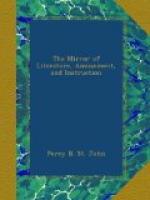Here the loud snoring of Lieutenant ——, put an end to the narration.
VYVYAN.
* * * * *
STUPENDOUS BRIDGE IN SPAIN.
[Illustration]
Bridges are amongst the noblest, if not the most ancient, triumphs of human art. Many of the specimens of former ages are admired for their massive solidity, as well as for the beauty of their architectural decoration. The present bridge, a fabric of the last century, has neither of these attractions, though it is constructed upon the best principle of modern bridge-building—that of having one single arch. Peronnet and De Chezi, two celebrated engineers, who are regarded as the founders of a new school of bridge architecture in France, made it their study to render the piers as light, and the arches as extended and lofty as possible; and the above bridge is a handsome structure of this class. It has been objected that the modern French bridges have not that character of strength and solidity which the ancient bridges possessed, and that in the latter, the eye is generally less astonished, but the mind more satisfied, than in the former. To these objections the Spanish bridge is by no means liable, as we shall proceed to show from its details.
The present bridge extends across the river, Guadiaro, in the South of Spain, and connects the romantic city of Ronda with its suburbs. The situation of the city, encircled by Guadiaro, is described by Mr. Jacob,[5] as follows:—
“It is placed on a rock, with cliffs, either perpendicular and abrupt towards the river, or with broken craggs, whose jutting prominences, having a little soil, have been planted with orange and fig trees. A fissure in this rock, of great depth, surrounds the city on three sides, and at the bottom of the fissure the river rushes along with impetuous rapidity. Two bridges are constructed over the




